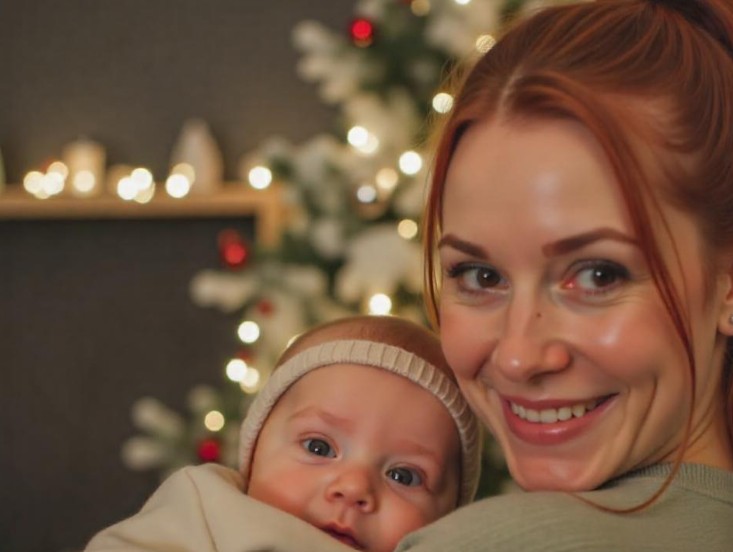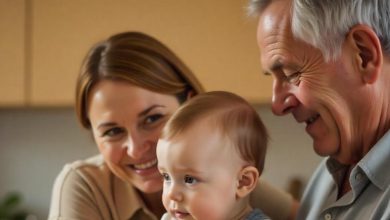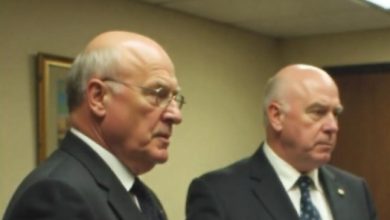Dismissed by Doctors Nine Separate Times — Now This Mother of a Little Boy Has Roughly One Year Left Because of a Deadly Disease

Georgia-Leigh Gardiner still remembers the December evening when the burning started high in her stomach, a small, sharp fire that felt like ordinary holiday indigestion. She was twenty-eight years old, active, and happiest when chasing her two-year-old son, Arlo, around their living-room floor. At first she blamed the pain on rich food, late nights, and the seasonal rush at work. She took antacids, skipped dessert, and promised herself rest in the new year. Instead of fading, the ache grew wider and deeper. Water made her gag, toast came back up, and within six weeks she had shed more than ten pounds.
Her first appointment at the local surgery ended with a familiar verdict: probably acid reflux, nothing to worry about. The doctor sent her home with lansoprazole and friendly advice to manage stress. Georgia-Leigh followed every suggestion, yet each morning she woke weaker, already bracing for the next wave of nausea. By February she had lost almost a stone, her energy felt drained by mid-afternoon, and simple tasks—lifting Arlo, climbing stairs—left her dizzy. She returned to the clinic with a diary of symptoms, but the second doctor skimmed her notes, repeated the reflux theory, and encouraged bland meals and peppermint tea.
March brought two trips to Leeds General Infirmary’s emergency department. The first time, she arrived after vomiting until her chest ached; the second, after a stabbing spasm bent her double. Both visits ended with gentle apologies, blood tests labeled “largely unremarkable,” and discharge papers that used phrases like “likely functional dyspepsia” and “return if symptoms persist.” Friends suggested anxiety, coworkers suggested a probiotic, and Georgia-Leigh tried each remedy in quiet despair. She watched her jeans slide off her hips and felt her cheeks grow hollow. She also noticed how doctors’ faces softened when she mentioned her age—they looked relieved, almost pleased. Serious illness, their eyes seemed to say, visits older bodies.
Spring blurred into early summer, and the Gardiner household shrank around her pain. Meals became battles; playtime became sitting on the sofa while Arlo drove toy cars across her knees. Callum, her fiancé, started working extra shifts as an electrician because the grocery budget no longer covered special shakes, ginger teas, and the taxi rides she needed when walking became too hard. He offered to push harder at appointments, but she worried that complaining would brand her as difficult.
Everything changed in May when her regular physician was on holiday and a new doctor, Dr Aisha Malik, completed the exam. Dr Malik listened without cutting her off and then, almost casually, performed a breast check after learning there was a bit of cancer history in the family. The physician felt a tiny lump and ordered an urgent referral on a “non-specific symptoms” pathway—a little-known fast track for patients with troublesome but unclear signs. The breast clinic quickly ruled out cancer, yet the same pathway sent her for an upper endoscopy.
The camera slipped down her throat and revealed a stomach wall that looked thick and ridged, not smooth. A CT scan followed within days, and on Friday, 13 June 2025, Georgia-Leigh and Callum sat in a consultation room at St James’ University Hospital. They had rehearsed questions about ulcers and minor surgery. Instead, a surgeon explained that she had poorly differentiated gastric adenocarcinoma—linitis plastica—an aggressive cancer that stiffens the stomach like leather and often hides until it spreads. In her case it had already crossed into the peritoneum, seeded lymph nodes near her lungs, and left spots the radiologist described as “concerning” inside the lungs themselves. Surgery was impossible. Chemotherapy might slow the march, and an experimental trial could add a few months, but statistics pointed to roughly one year.
Georgia-Leigh laughed once, a short burst of disbelief, and asked Callum if it was a joke. The consultant shook his head. They drove home in silence. For three days she barely spoke, scrolling through photos of Arlo’s first bath, last autumn’s pumpkin patch, the moment Callum knelt in the garden with a ring. Each picture felt like a promise the future could no longer keep. When she finally tried to explain the diagnosis to her parents, the words tangled: “Stage four… no cure… time, just time.”
Then something inside her clicked from shock to action. She called Macmillan Cancer Support, joined an online group for young adults with stomach cancer, and opened a bright yellow notebook. On the first page she wrote “Project Hope,” and beneath it a list: start chemotherapy in July; confirm biopsy results for a clinical trial; move the wedding to September while she still had strength; record a weekly video diary for Arlo; plan small adventures—a beach weekend, a zoo trip, maybe an early Christmas if needed. She taped the list to the fridge so every visitor could see goals, not a countdown.
Chemotherapy, a mix called FOLFOX-IRI, would aim to slow growth and ease pain. Side-effects loomed—numb fingers, mouth sores, crushing fatigue—but she agreed without hesitation. Tumor samples were also tested for markers that might open doors to a combination of immunotherapy and a targeted antibody drug in a national study. Between hospital visits she booked sessions in a hyperbaric oxygen chamber, followed a gentle yoga routine on days she felt steady, and tried an alkaline-leaning diet, though her oncologist reminded her that calories mattered more than pH strips.
Cost sat heavy on their minds. A friend created a GoFundMe titled “Time for Georgia,” and local newspapers shared her story: a young mother whose stomach pain had been waved away until it turned deadly. Donations poured in—small notes from pensioners, larger gifts from anonymous strangers, and an envelope of coins from a primary-school class who had baked cupcakes. In three weeks the fund topped nine-thousand pounds, enough to cover travel to appointments, specialized nutrition drinks, and maybe a visit to the Hallwang Clinic in Germany if UK options ran out.
Community support reached beyond money. A women’s ballroom evening sold two-hundred tickets in forty-eight hours; neighbours dropped casseroles; a mechanic replaced the exhaust on their old car for free so it would not break down on chemo days. Each act felt like a thin beam of sunlight through thick cloud.
With the wedding clock now ticking faster, the Wedding Wishing Well Foundation offered to plan the event. Italy had once been the dream, but a converted stone barn an hour away felt perfect. Volunteers strung fairy lights, a bakery donated a three-tier cake, and a local quartet promised to play her favourite song, “Can’t Help Falling in Love,” as she walked—perhaps slowly, perhaps supported by Callum—toward the vows. Her dress, ivory lace with romantic sleeves, came from a boutique that refused payment.
Meanwhile, she began filming herself on her phone: reading “Guess How Much I Love You,” talking about the day Arlo was born, describing how hard and brave life can be. She stored each clip in a folder labelled “For Every Birthday.” She also penned letters—one for his first day of school, one for when he turns thirteen, one for the night before his wedding—because paper, she said, does not forget.
When the first chemotherapy session arrived, nurses covered her in warm blankets and explained every drug. The drip line hissed; cold flooded her arm; nausea crept in. She closed her eyes and pictured Arlo’s grin. Later, at home, she lay on the sofa whispering three positives to herself: the nurse who rubbed her shoulder, the stranger who sent a card, the fact that pain meant she was still here.
Social media became her megaphone. She posted honest updates—IV poles, bald patches, good days twirling with Arlo in the garden, bad days curled around a bucket. She ended each message the same way: “Early voices save lives. If pain stays, shout louder.” Followers thanked her, some said they booked overdue tests because of her warning, and a few shared new diagnoses caught earlier than hers.
Doctors cannot rule out miracles. Younger patients sometimes outlive grim charts, and new drugs appear yearly. Yet she keeps her gaze on the practical gift of time: an extra Christmas tree, a few more mornings of tiny footsteps running into her room, the chance to kiss Arlo’s scraped knees and tell him bravery is not the absence of fear but the choice to keep moving.
At night she sometimes wonders what life would look like if someone had ordered imaging in January instead of June. Could surgeons have removed the cancer? Would she be planning Arlo’s third birthday without the word “terminal” echoing in her head? She lets the thought pass, because regret steals strength from the hours she still owns.
Medical experts who reviewed her file agree earlier action could have created a different path. Linitis plastica is rare, yet its early clues—rapid weight loss, persistent vomiting, relentless pain—should never be waved away. Studies show that women’s symptoms, especially gastrointestinal complaints, are more likely to be labeled anxiety or diet-related. Georgia-Leigh now lends her voice to campaigns urging automatic scans after two unresolved visits, regardless of age or gender. Bias, she says, almost cost her the chance to fight; she will not let it silence others.
As July fades toward August, she measures progress in small units: being able to taste a strawberry again, walking Arlo to the park without stopping twice, sending an application to join the trial if her lab results qualify. Callum reads research papers late at night, checks on her as she sleeps, then writes notes thanking the people who have helped them breathe easier.
In quiet moments she sits in the garden, feels the sun on her skin, and reminds herself that statistics are not certainties. She is determined to be an outlier, to stretch twelve months into fifteen, maybe twenty, maybe more. Even if science cannot keep her here as long as she wishes, she knows love will linger in every story Arlo tells about the mother who taught him to plant sunflower seeds, count the stars, and always, always speak up when something hurts.
Her life now moves between hospital corridors and bursts of joy: choosing flower crowns for the wedding, laughing when Arlo insists the IV pump looks like a robot, resting when the fatigue crushes her, then rising again because rising is the only option. She keeps the yellow notebook close, adds new goals, scratches off completed ones, and writes a sentence on the back cover in thick black ink: “Different future, same fierce heart.”
If there is one lesson she repeats to anyone who asks, it is simple. Pain that lingers is not imaginary. Weight that falls away is not always diet success. Youth is not a shield, and silence is not strength. She hopes her voice will echo in clinic rooms, pushing doctors to pause, to scan, to believe the person in front of them even when textbooks whisper otherwise. Every early test, she says, is a door to possibility, and possibility is life.
Georgia-Leigh Gardiner may not know exactly how many seasons remain, but each sunrise she opens her eyes to Arlo’s smile, feels hope rise with the light, and chooses once more to fight for another memory, another kiss, another ordinary miracle.



